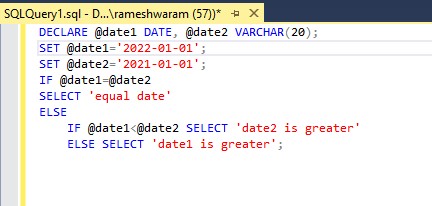In SQL databases, handling dates is a fundamental task, especially when you need to analyze or manipulate data based on temporal criteria. For those new to SQL, date formats and comparisons can initially seem tricky. This guide will walk you through the essentials of comparing dates in SQL, focusing on clarity and practical examples to enhance your understanding and database querying skills.
SQL provides the DATE datatype, designed specifically for storing date values without time components. The standard format for DATE in SQL is YYYY-MM-DD. When working with databases, ensuring your input dates match this format is crucial for accurate data storage and retrieval. Furthermore, SQL also offers DATETIME or TIMESTAMP datatypes when time precision is required alongside the date. However, for simply comparing dates, the DATE datatype is perfectly adequate.
Comparing dates in SQL is straightforward and primarily achieved using standard comparison operators: equals to (=), less than (<), and greater than (>). These operators work intuitively with the DATE datatype, allowing you to easily determine the chronological order or equality of dates. To illustrate these comparisons, we’ll use the IF-ELSE statement in SQL, a powerful control flow tool that lets you execute different SQL statements based on conditions.
Understanding the IF-ELSE Statement in SQL
The IF-ELSE statement in SQL allows for conditional execution of code blocks. It evaluates a boolean expression, and based on whether the expression is true or false, it executes a corresponding block of SQL code.
Syntax:
IF Boolean_expression
BEGIN
{ sql_statement | statement_block }
END
[ ELSE
BEGIN
{ sql_statement | statement_block }
END ]In this syntax:
Boolean_expression: A condition that evaluates to either TRUE or FALSE. This is where our date comparisons will reside.sql_statementorstatement_block: The SQL code to be executed. If you have multiple statements, enclose them withinBEGINandENDblocks.
Declaring and Setting Date Variables in SQL
Before we can compare dates, we need to declare variables to hold our date values. SQL uses the DECLARE keyword to define variables. Local variables are typically prefixed with the @ symbol.
Syntax for Declaring a Variable:
DECLARE @variable_name datatype;Syntax for Setting a Variable Value:
SET @variable_name = value;Now, let’s delve into practical examples of comparing dates in SQL using these concepts.
Example 1: Comparing Two Dates for Equality
In this example, we will declare two date variables, @date1 and @date2, and set them to different dates. We will then use an IF-ELSE statement to check if they are equal, or which date is greater.
DECLARE @date1 DATE, @date2 DATE;
SET @date1 = '2021-01-01';
SET @date2 = '2021-02-02';
IF @date1 = @date2
SELECT 'Equal dates'
ELSE IF @date1 < @date2
SELECT 'date2 is greater'
ELSE
SELECT 'date1 is greater';Output:
In this case, since @date1 (‘2021-01-01’) is less than @date2 (‘2021-02-02’), the output correctly indicates “date2 is greater”.
Example 2: Comparing Dates with the Same Value
Here, we’ll demonstrate comparing dates that are actually the same. Notice that even if we declare @date2 as VARCHAR(20) and assign a date string, SQL can still implicitly convert it for comparison with a DATE datatype variable in many contexts. However, it’s best practice to keep datatypes consistent for clarity and to avoid potential implicit conversion issues in complex queries.
DECLARE @date1 DATE, @date2 VARCHAR(20);
SET @date1 = '2021-01-01';
SET @date2 = '2021-01-01';
IF @date1 = @date2
SELECT 'Equal dates'
ELSE IF @date1 < @date2
SELECT 'date2 is greater'
ELSE
SELECT 'date1 is greater';Output:
As expected, when both dates are set to ‘2021-01-01’, the condition @date1 = @date2 is true, and the output is “Equal dates”.
Example 3: Demonstrating the “Greater Than” Comparison
In this final example, we’ll set @date1 to a later date than @date2 to showcase the “greater than” comparison.
DECLARE @date1 DATE, @date2 VARCHAR(20);
SET @date1 = '2022-01-01';
SET @date2 = '2021-01-01';
IF @date1 = @date2
SELECT 'Equal dates'
ELSE IF @date1 < @date2
SELECT 'date2 is greater'
ELSE
SELECT 'date1 is greater';Output:
Here, @date1 (‘2022-01-01’) is indeed greater than @date2 (‘2021-01-01’), resulting in the output “date1 is greater”.
Conclusion
Comparing dates in SQL is a fundamental operation made simple by SQL’s built-in DATE datatype and standard comparison operators. By using operators like =, <, and > in conjunction with control flow statements like IF-ELSE, you can implement complex logic based on date comparisons in your SQL queries. Understanding these basics is essential for effectively managing and querying time-sensitive data within your databases. Whether you’re filtering records, scheduling events, or analyzing trends over time, mastering date comparison in SQL is a crucial skill for any database professional or enthusiast.

